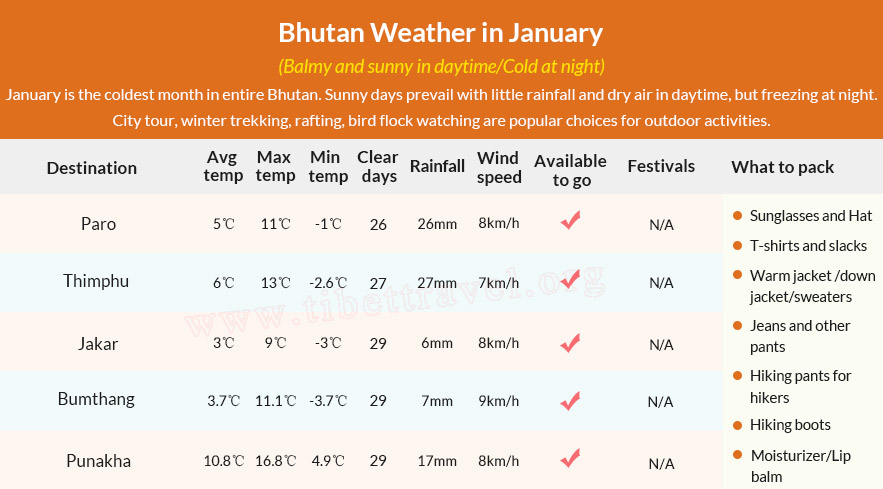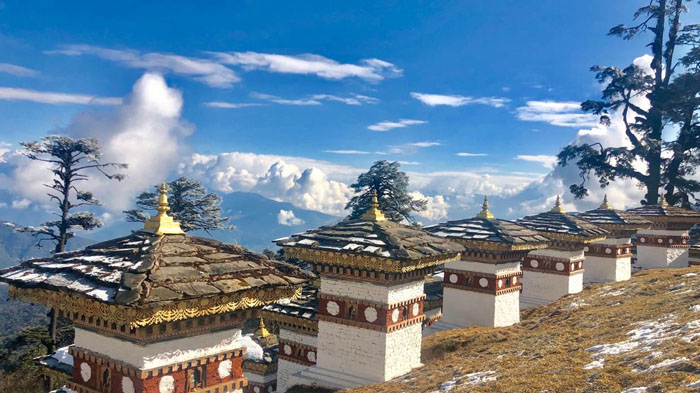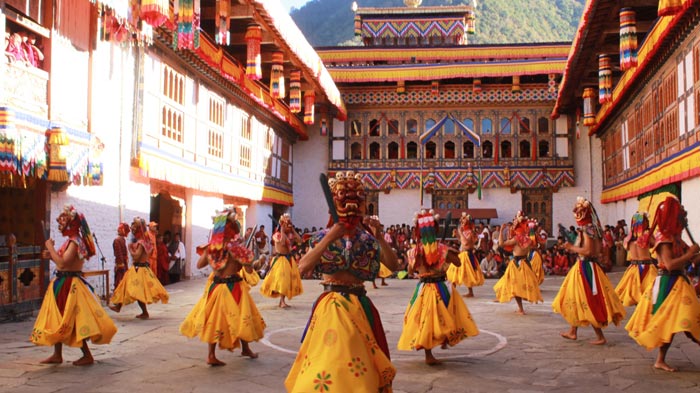
Bhutan Weather and Tour in January: is January a good time to visit Bhutan?
January is the middle of the winter season in Bhutan, and as an off-peak season for the tourism industry in the kingdom, it is actually a great time to visit. Not only can you experience all the best parts of Bhutan on your tour, but you can also have the opportunity of avoiding the crowds. Touring Bhutan gives you the chance to explore and experience the simple spiritual life of 21st-century Bhutan, with its unique culture and people, and the stunning landscapes and sceneries.
Unlike some high-altitude countries and regions, the winter in Bhutan is easily bearable, with average temperature ranging from -3 to 12 degrees, which is really no colder than many parts of the north of Europe or the northern States of the US. It does snow in Bhutan in January, but usually only in the northern and northwestern districts (Dzongkhags), around the areas of the mighty Himalayas, which lie on Bhutan’s northern border with Tibet. However, heavy snow is actually quite rare in Bhutan but if you are lucky, you can experience the rare heavy snowfalls in Thimphu, Paro and Bumthang areas in this month.
The Climate and Weather Condition of January in Bhutan
Lying on the southern edge of the Himalayas, Bhutan does not have the harsh climate of Tibet. The weather in the kingdom depends mainly on altitude. Typically, the further east and south you travel, the warmer the weather becomes. Meanwhile, as you get higher, the weather does get colder. In January, the southern areas of the country are still warm to hot, with temperatures ranging from 10 degrees at night to around 18-20 degrees during the day.
In the central region of Bhutan, around Trongsa Dzongkhag, the temperatures are still mild in this month, with daytime temperatures averaging a balmy 12 °C to 13 °C and sometimes getting down to around freezing at night. In the northwest of the kingdom around Paro Dzongkhag and in the northeast around Bumthang Dzongkhag, the temperatures do drop lower, with daytime temperatures of around 8-9 degrees, dropping to around -5 at night.

Insider tips:
1. Despite the freezing weather in Bumthang area, the charming winter views of the Bumthang valley is no doubt a fairy land which definitely can’t miss.
2. Due to the low altitude, the Punakha valley which lies in the central or mid-western part of Bhutan becomes surprisingly warmer than any other towns and areas in western Bhutan. It is also widely regarded as the best place to catch the rare glimpse of the black-necked cranes in January.
To help you get more information about the January weather and climate in Bhutan’s most attractive towns and regions, we have collected the latest and detailed Bhutan weather and climate information about the towns and regions listed below.
Paro weather in January
Average Maximum Temperature: 11 °C/52 °F
Average Minimum Temperature: -1 °C/30 °F
Average Temperature: 5 °C/41 °F
Precipitation: 26 mm
Clear Days: 26 days
Wind Speed: 8 km/h
With its location in western Bhutan, Paro (2,200 m) in January is still in its winter time. Although it is chilling cold at night, in the daytime, the warm sunshine kisses the ground, making the sensible temperature a bit higher and bearable. Sunshine days dominate the entire month with the daily mean temperature ranging from the minimum of -1 °C to the maximum of 11 °C.
The precipitation in January upswings a little bit when compared to December, however, in the late of this month, the entire town may be possibly stricken by a few days’ a snow shower in the early morning or late at night. If you are lucky, you can possibly witness Paro turning into a snow and ice land by one night’s heavy snow in this month.
The wind in Paro January tends to be moderate with the wind speed approximately at 12 km/h. It is possible for you to plan a short few days’ trek in main towns or around the Punakha, Thimphu, Paro and Bumthang areas, or you can also carry out a culture themed outdoor activity in January to enjoy the winter Paro.
Thimphu weather in January
Average Maximum Temperature: 13 °C/55 °F
Average Minimum Temperature: -2.6 °C/27.3 °F
Average Temperature: 6 °C/43 °F
Precipitation: 27 mm
Clear Days: 27 days
Wind Speed: 7 km/h
The capital city Thimphu (2,334 m) is just 55 km away from Paro and an only 2-hour drive from it. So the weather of both major towns bares a lot of similarities in January. You can expect moderate temperature ranging from 12 °C to 15 °C during the day, however, at night, the temperature drops to the freezing point or a few degrees lower than that.
 Winter Dochula Pass with charming stupas or chortens and deep-blue sky.
Winter Dochula Pass with charming stupas or chortens and deep-blue sky.
If you plan a trek embarking on an uphill climb, you need to bring the down filled or cotton padded coat, for the higher place you reach, the colder the weather tends to be. With less rainfall and perfect sunshine, the sensible weather in daytime is much higher than expected and you may feel comfortable no matter you are doing outdoor trekking or just taking a city tour.
In January, you may encounter two or three days’ morning or evening showers but the weather soon turns to be fine. Besides Thimphu also provides great weather for adventure activities like white water-rafting or the bird watching too. If you are lucky, you have the chance to enjoy snowfall in January.
Jakar weather in January
Average Maximum Temperature: 9 °C/48 °F
Average Minimum Temperature: -3 °C/27 °F
Average Temperature: 3 °C/37 °F
Precipitation: 6 mm
Clear days: 29 days
Wind Speed: 8 km/h
Jakar (2,587 m) is another popular town locates in Bumthang valley in central Bhutan. Accepted as a place having the most beautiful valleys, Jakar, including the Bumthang area, is never confined to its spring and autumn charm, instead, the snow and ice fairy land in winter has attracted more and more locals and worldwide visitors to come.
Though the temperature of Jakar suffers from a gradual decline in January, the daytime weather remains to be perfect with plenty of sunshine and great visibilities. Besides the conventional visit to the famous town tourist sites, the travel which takes you to Jakar, as well as Bumthang valley, may possibly surprise you with heavy snowfall and a rarely seen winter land.
However, most of the days are sunny with daytime temperature maintaining at a comparatively higher level, while at night, temperature falls below the freezing point and the weather turns to be chilly, sometimes accompanied by the continuous snowfalls, making the entire town cladded with silver white.
Rainfall is rare in this month. It just happens in a few days’ morning or at late night. With mild and temperate daytime weather in Jakar, the world-renowned adventures for you to explore are the scenic valleys as well as historical and spiritual legacies including Bhutan’s oldest and most venerated temples and monasteries, etc. No matter wherever you go, wear layers and a down feather clothes.
Insider tips:
1. Heavy snows do fall in Bumthang area including the main town Jakar in January. Large snowflakes fall from the sky, making roads and house roofs covered with surprisingly thick snows.
Tree branches are condensed with crunchy but frozen solid snow ice while on the ground, deep foot prints are left as people pass by. Wake up early in the morning and get properly dressed. Don’t miss the amazing winter Bumthang valley in Bhutan January.
2. The sunshine in the daytime is balmy with a little bit strong ultraviolet ray, so if you have a long-time exposure under the sun, wear the sunscreen before you leave the hotel.
Bumthang weather in January
Average Maximum Temperature: 11.1 °C/52 °F
Average Minimum Temperature: -3.7 °C/ 25.3 °F
Average Temperature: 3.7 °C/38.7 °F
Precipitation: 7 mm
Clear days: 29 days
Wind Speed: 9km/h
Bumthang area is famous for its gorgeous and lovely valleys, and among them, Ura, Chumey, Tang and Choekhor valleys top the most. The choekhor valley is the largest and widely considered as the "Bumthang Valley". With wide visual fields, the valleys in Bumthang are the most attractive in Bhutan by their scenic natural views as well as the isolated but majestic temples.
Bumthang in January is cold with the average temperature ranging from -4 °C to 11 °C. However, you may still feel much warmer than you have expected in the daytime, for most of the January days are sunny. Rains are hardly seen in this month, and, if any, are always rain showers in the morning or at night.
In valleys, the wind is moderate but the winter air remains to be dry, so keep your skin moisturized with sunscreens if you stay outside for a long time.
Insider tips:
Bumthang area and Jakar share the identical weather features. So if you find yourself in a world of snow and ice, don’t feel shocked but just get prepared to embrace the heart-touching sceneries outside.
Punakha weather in January
Average Maximum Temperature: 16.8 °C/62.2 °F
Average Minimum Temperature: 4.9 °C/40.8 °F
Average Temperature: 10.8 °C/51.4 °F
Precipitation: 17 mm
Clear days: 29 days
Wind Speed: 8 km/h
Punakha area lies between the Thinphu valley and the Bumthang valley at a much lower altitude of 1,214 m. With a suitable climate for growing rice, Punakha valley is famous for rice farming. Though the crop-planting season is yet to come in January, large pieces of farmlands can be sighted. Smokes are curling up from the chimney while the peaceful rural scenes are near at hand.
Due to the lower altitude, the weather is much warmer than most of Bhutan’s western and central towns. The average maximum temperature in January increases to 16.8 °C while the average minimum temperature surprisingly maintains at a comparatively high level of 5 °C, making organic vegetables and kinds of fruits easy to be planted in the fields and orchard gardens.
In January, most of the days are sunny, but you may come across a couple of days with quick rain shower in the morning. Showers of Punakha in this month never blur the distant view of the stunning farmland which extends as far as eye can see, rather, the hazy morning makes the valleys more mysterious and attractive for you to explore.
When the sunshine drives away the haze, the air turns back to be dry. With moderate wind, the daytime weather, in general, is comfortable while at night, this is no problem to stay overnight outside. Try ascending to the mountain hills to have an overlook of the winter valleys and don’t forget to bring a down jacket with you.
What about Bhutan tours in January?
January is one of the great months to carry out many outdoor activities, from the stunning winter treks around the hills and mountains of this Himalayan kingdom to the awesome colorful festivals. The history and culture themed tours are also good options in January.
 Lamas carrying life necessities to Gangtey Monastery wearing slippers in January.
Lamas carrying life necessities to Gangtey Monastery wearing slippers in January.
The classic Bhutan tour gives you lots of sightseeing in Paro, Thimphu, and Punakha like the Kyichu Lhakhang, the Paro Rinpung Dzong, the Taktsang Goemba or known as “Tiger’s Nest Monastery”, and the National Museum of Bhutan, the King's Memorial Chorten, the National Library, the Folk Heritage Museum, and the Tashichho Dzong. The tours also take you to Wangdue Phodrang and Gangtey. You will get to spend some time in the most enchanting valley in Bhutan, the Phobjika Valley or the Bumthang valley.
Below we have carefully selected some Bhutan classic tours with short treks for you:
>> 4 Days Bhutan Impression Tour
>> 5 Days Popular Highlights of Bhutan Tour
>> 6 Days Cultural Discovery Tour in Bhutan
How about Bhutan trekking in January?
Bhutan is not a place where you cannot trek in the winter, and with the milder climate, it is possible to take on many of the treks in this Himalayan kingdom even in January.
These winter short treks take you from Bhutan capital or Paro to a great number of awesome places in Wangdue Phodrang and Punakha Dzongkhags through rich ancient ever-green forests and traditional local villages where huge rice fields, fruit-bearing forest and orchid gardens can be sighted.
Winter gives many pleasant surprises to the trek in Bhutan and it makes each trekking route with its own uniqueness. In Phobjikha Valley of Wangdue Phodrang district, the rarely seen black-necked cranes which have finished their annual swoop into this warm place have attracted a great number of locals and tourists to brave the cold weather for a close-up view.
 Winter treks with clear sky and balmy sunshine in the daytime.
Winter treks with clear sky and balmy sunshine in the daytime.
Besides, treks to the Samtengang offer you an incomparably spectacular view of winter Bhutan Himalaya Mountains. With the clear sky and broad views, the fantastic visibility makes the undulating mountains behind look much more magnificent.
Insider tips:
Black-necked cranes are revered in Bhutan as a symbol of longevity, and they are protected by Bhutanese laws with the threat of life imprisonment for anyone who harms this sacred species. Worshipping the sacred bird and have an enjoyable bird flock watching surely add more fun to your winter trekking in Bhutan.
We have carefully selected some Bhutan winter trek tours with specific routes and arrangements for you:
The Samtengang Winter Trek
The Punakha Winter Trek
3 Days Bumthang Culture Trek
6 Days Druk Path Trek
Insider tips:
1. We have provided some other popular Bhutan trekking routes to present more choices.
2. In January, the following trekking routes are not recommended:
3 Days Bumthang Owl Trek - You can hardly find any Bhutan owl in January, for they have already hidden deep in the forests.
12 days Jomolhari Trek - The Jomolhari trek takes you to Linzhi, a high altitude place in northwestern Bhutan which, with chilly weather and snow blocked trails, is inappropriate for trekking in January
31 Days Snowman Trek - The snowman trek is generally regarded as the most difficult trek in the world and it is not wise to embark on this tour in the winter season. Besides, in some sections of this trek, up on the places at higher altitude, the trekking trails are blocked by the heavy snow, which can easily jeopardize the whole tour.
Festivals in January
Festivals in Bhutan are huge social occasions, and a time for families. Local people dress up in their finest clothes, often traditional costumes that are colorful and resplendent with fine jewelry, and spend the whole day at the festival, taking food with them to eat throughout the day as a picnic. Festivals are normally held in the Dzongs or monasteries, and are a stunning display of masked dances, performances, and traditional tsachu that have taken weeks or months to prepare. There are, however, no festivals in January 2021, as the dates of the festivals rely on the lunisolar calendar. The three festivals that are normally in January were held in December 2018. These festivals are:
Trongsa Tshechu - Set in the heartland of Bhutan, Trongsa Dzongkhag, the festival is held on the 10th day of the 12th month in the Bhutanese calendar, and celebrates the anniversary of the birth of Guru Rinpoche, also known as Padmasambhava. The festival is held in the courtyard of the Trongsa Choekor Rabtse Dzong and features mask dances, Bhutanese tsachu or operas, and songs and dancing from the local villagers and townsfolk. One of the biggest events in the region, the festival is a day of holiday for the locals to celebrate.
 Lhuentse Tshechu is held in the Lhuentse Dzong of Bhutan.
Lhuentse Tshechu is held in the Lhuentse Dzong of Bhutan.
Lhuentse Tshechu - Usually held in the first week of the tenth month of the Bhutanese calendar, the festival is held in the Lhuentse Dzong in Lhuentse Dzongkhag in the northeast of Bhutan. Held after the rice harvest season is over in the region, which is usually around the end of November to the middle of December, it is the most popular festival of the district, and people travel from miles around to attend the celebrations. Celebrated with mask dances and blessings from the high lamas, the festival is known for the colorful clothes of the Kishuthara, which Lhuentse is famous for, and lasts for around five days.
Nabji Lhakhang Drup - Held in the Nabji Lhakhang in Nabji, Trongsa Dzongkhag, in the village temple, this unique festival is popular for its unique dances, known as the Tercham, or “Dance of the treasure”, and the Mewang, or “Fire Dance”. The festival has important connections to the famous Terton, Pema Lingpa, and the dances are believed to bless infertile women to be with child, and were originally performed by naked masked dancers around a huge bonfire.
When is the best time to visit Bhutan?
For most people, there is no “best” time to visit Bhutan, as the kingdom can be visited at any time of the year. However, for the best tourist seasons, you should visit in spring and autumn, from March to May and September to November. This is when the weather is dry and bright, with no rain, and perfect for trekking. If you want fewer tourists and a quieter tour, then winter and summer, from December to February and June to September, are the best times of the year. Summer can get a little wet in some parts of the country, as it is the monsoon season, and the winter can be colder in the far north, but overall, there are many advantages to visiting in the low seasons.
>> Further reading about when is the best time to trek Bhutan?
What to pack for visit Bhutan in Jan?
Depending on where you are heading in January, you may need to pack some warm weather clothes, as the south of the country rarely gets cold at all. In the north, however, you will need to have warmer clothing to beat the colder weather of the winter. If you are hiking, then you should include hiking boots and plenty of layers to keep you warm or cool as you trek For those not trekking, a decent strong pair of boots or shoes is essential, as the roads in Bhutan are not all paved, and ground can be rough in some places. The winter is a sunny time of year, so you will need sunglasses and a hat, since the sun can get a little stronger than you might expect. The northwest is quite windy too, so moisturizer and lip balm for the chaffing winds is a good idea. Otherwise, you can bring normal clothes that you would wear anywhere else, such as t-shirts and slacks, jeans and other pants, hiking pants for hikers. Bring warm sweaters and at least one down jacket, as it can get chilly at night.
Is it easy to get the Bhutan Visa in January?
Bhutan does not have any restrictions on when you can visit the kingdom, and is open all year round. However, as January is the low season for tourism, it does mean fewer tourists applying for the Bhutan Visa. The Department of Immigration does say that visas are normally processed within five working days in the peak season, so it is entirely possible that the visa may be processed faster if there are fewer applications. Other than that, it is always easy to get the visa, as long as you meet the requirements for travel to Bhutan and are using a reputable tour operator.
Conclusion
The weather in January is typically balmy and temperate in most of the country. With plenty of sunshine and barely any rains, the air turns to be dry and the sky becomes surprisingly clear. The outdoor sceneries are perfect, especially in the Punakha and Thimphu valleys. Ascend to some trekking mountain hills, like mountains along the Druk Path Trek or the Samtengang Winter Trek, to catch a rare glimpse of the immaculate Himalaya Mountains.
However, in western Dzongkhags (Districts) or central regions like Paro and Bumthang valley, the weather is balmy in the daytime but turns to be chilling cold at night. Bumthang valley in winter presents you a stunning beauty especially in January and February, so book the hotel with heating and get layers and winter down coat well packed. Never miss the winter views of Bhutan valleys.
The weather of Thimphu and Paro is almost sunny with dry air in the daytime. The temperature becomes mild but at night it falls rapidly below the freezing point. Heavy snow is likely to fall in this month at night, accompanied by comparatively cold wind. If you are lucky, you have the chance to get stunned by another ceaseless snow festooned Bhutan next morning.
January is regarded as the low season for Bhutan tourism, but January is also accepted as an ideal time to visit if you want the real peace and tranquility that this spiritual land has to offer. In January, the tour cost remains to be far cheaper than that in high seasons, so why not to extend your holiday budget a little further for a longer tour, for the entire Bhutan is adventurous and worth the cost in all perspectives.

I am a tour guide in Tibet an was Born in Kham Tibet, I am the father of 2 little girls, bachelor's degree. I have more than 7-years experience of being a tour guide in Tibet. I am a warm, friendly, knowledgeable and attractive guy.


.jpg)



0 Comment ON "Bhutan Weather and Tour in January: is January a good time to visit Bhutan?"